1. Introduction
 Plextor recently released the 755A. It now follows with another new drive, breaking the barrier of 16X burning speed. The PX-760A offers 18X writing speed for DVD+/-R media, which makes it the only drive to date that offers this speed. However, the DVD-R DL writing speed remains at 6X, while it can burn DVD+R DL at 10X.
Plextor recently released the 755A. It now follows with another new drive, breaking the barrier of 16X burning speed. The PX-760A offers 18X writing speed for DVD+/-R media, which makes it the only drive to date that offers this speed. However, the DVD-R DL writing speed remains at 6X, while it can burn DVD+R DL at 10X.
So, let's move on and have a look at the drive's main features and specifications as found on Plextor's web-site.
- Features
 For the best writing quality, the drive's AUTOSTRATEGY technology selects the optimized write strategy for every DVD disc and, if necessary, creates a new write strategy for unknown media (DVD+/-R).
A separate database stores all strategies that are created by the AUTOSTRATEGY function for media that is not currently supported in the firmware. A maximum of 31 write strategies can be held in the drive's non-volatile memory. The entries can be activated or de-activated, and deleted. The list of database entries can be viewed and saved or printed.
For the best writing quality, the drive's AUTOSTRATEGY technology selects the optimized write strategy for every DVD disc and, if necessary, creates a new write strategy for unknown media (DVD+/-R).
A separate database stores all strategies that are created by the AUTOSTRATEGY function for media that is not currently supported in the firmware. A maximum of 31 write strategies can be held in the drive's non-volatile memory. The entries can be activated or de-activated, and deleted. The list of database entries can be viewed and saved or printed.
The user can select the write strategy from the AUTOSTRATEGY database or from the database that resides in the drive's firmware by activating a different Mode.
Remark: This function is only available for DVD+R and DVD-R media (4X and higher).
- Auto Selection Mode:
The drive will select the best write strategy, whether it is located in the AUTOSTRATEGY database or in the firmware database. If no suitable strategy is found, AUTOSTRATEGY will create a new, optimized strategy in the database.
- AUTOSTRATEGY On Mode (Forced):
The drive will create a new write strategy for every new recording, whether a corresponding strategy exists already in the firmware or not.
- AUTOSTRATEGY On Mode:
The drive will use the write strategies from the AUTOSTRATEGY database for recording. If no suitable strategy is found, a corresponding write strategy from the firmware's database will be used.
- AUTOSTRATEGY Off Mode:
The drive will only use the write strategies from the firmware's database for recording. If no corresponding write strategy is found, the default write strategy will be used.
Media Quality Check
To assure you're getting the best results with your drive, this function checks the quality of blank media.
Write strategy creation
This function offers to create a new write strategy for your blank media. The drive will create a new write strategy in the AUTOSTRATEGY database without recording on a disc. It is possible to create several write strategies for the same media, which can be useful if there is a quality difference among media with the same MID code.

PlexEraser is a data destruction utility that makes a recorded CD-R or DVD disc unreadable. The drive will "re-record" over the Lead-in and data sectors of a write once disc rendering the disc data unusable. Initially, this feature will support DVD+/-R and CD-R media. Firmware upgrades will add support for DVD+/-R DL media.
SecureRecording
The SecureRecording function lets you write on a CD-R disc and protect the data with a password. To view the contents of a password-protected disc-or even to see a catalog of files-the user must enter the correct password. The password can be entered via PlexTools Professional software, or with SecuViewer software.
Buffer underrun proof
The buffer underrun proof technologies offer a solution to prevent writing failures during the burning process for CD and DVD by pausing the burn if the data to the drive write buffer is slowed or stopped. The drive resumes the burn process after the drive write buffer is refilled.
Silent mode
If the drive needs to be used in a quiet environment, the drive can be switched to silent mode. Unique technology that sets the drive for super-silent operation. By controlling access speed, read/write speed, and tray opening and closing speed, you reduce drive noise to a whisper. This technology is excellent for recording studios or offices where low noise is required.
SpeedRead
Enable reading CD-R media up to the maximum speed of the drive. Discs that may be damaged due to mishandling or improper use may shatter due to the higher rotational forces reached at the maximum read speed of the drive. The drive's maximum read speed is therefore limited as a safety function. SpeedRead enables the user to increase the read speed of the drive to the maximum possible. Plextor recommends examining each disc before enabling this function.
GigaRec
GigaRec lets you change the recording capacity of a standard CD-R disc from 70 percent up to 130 percent of its standard capacity. You can use GigaRec for CD-DA or data writing at 4X and 8X disc-at-once (DAO). The feature allows you to get that extra storage on a single disc for a larger project. For smaller projects, like an audio master, the feature enables you to use the entire capacity of the disc, increasing the size of the pits and lands for higher reproductive quality.
 VariRec provides user adjustment of the recording power above or below a default level. The default level reflects an optimized laser power setting with reduced jitter. Changing this setting will result in a change of sound or sound quality and may increase the playability or compatibility with existing players.
VariRec provides user adjustment of the recording power above or below a default level. The default level reflects an optimized laser power setting with reduced jitter. Changing this setting will result in a change of sound or sound quality and may increase the playability or compatibility with existing players.
Q-Check
PlexTools Professional software provides a suite of diagnostic tests for blank and recorded media. The pre-recording tests of blank media allow you to choose the best media brands and recording parameters for your drive. The post-recording tests quantify the recording session and provide analyzer-type results to guarantee you're getting the best recording possible.
 Plextor Optimized Writing Error Reduction Control (PoweRec) adjusts laser power and writing speed so they're at the optimum settings for that particular disc. Using real-time monitoring of the write data, PoweRec can increase or decrease write power and speed to guarantee the best possible writing quality with whatever brand media is used.
Plextor Optimized Writing Error Reduction Control (PoweRec) adjusts laser power and writing speed so they're at the optimum settings for that particular disc. Using real-time monitoring of the write data, PoweRec can increase or decrease write power and speed to guarantee the best possible writing quality with whatever brand media is used.
- Specifications
| Model |
Plextor PX-760A |
| Write Speed |
DVD+R 18X |
| DVD-R 18X |
| DVD+RW 8X |
| DVD-RW 6X |
| DVD+R DL 10X |
| DVD-R DL 6X |
| CD-R 48X |
| CD-RW 24X |
| Read Speed |
DVD-ROM 16X |
| CD-ROM 48X |
| Technical Specifications |
| Interface |
IDE/ATAPI |
| Data buffer |
2 MB |
| Access Time |
<100ms (CD); <150ms (DVD) |
| Mean time between failures (MTBF) |
60 000h |
| Disc Loading |
Tray (50.000 times) |
| Bezel replaceable |
Black bezel included in retail version |
| Digital Audio |
S/P DIF output |
| Dimensions |
146 x 41,3 x 170 mm |
| Weight |
< 1Kg |
| Warranty |
2 year Fast Warranty Service (in EU, Norway and Switzerland: Collect & Return)
1 year in other countries |
| System Requirements |
PC/AT compatible |
| CPU: Pentium 4 - 1.4 GHz |
| RAM: 256MB |
| HDD: 10GB free space |
| OS: Windows 98SE/Me/2000/XP |
| Compatible Formats |
DVD: DVD-ROM, DVD-Video, Multi-Border, Multi-Session, DVD+VR, DVD-VR, DVD+MRW (by firmware upgrade), DRT-DM |
| CD: CD-DA (CD-DA/CD+G/CD-TEXT), CD-ROM (Mode1/Mode2), CD-ROM XA (Mode2
Form1/2), Audio CD, Data CD, Photo CD, Video CD, CD-I, CD-I Ready,
Mixed CD, CD-Extra, Multi-Session CD, Packet Write CD (Mount Rainier by
firmware upgrade)), Bootable CD |
| Performance |
DVD+R |
18x: 24,930KB/s (CAV), 16x: 22,160KB/s (CAV), 12x: 16,620KB/s (PCAV) ,6x-8x: 8,310-11,080KB/s(PCAV), 6x: 8,310KB/s (CLV), 4x: 5,540KB/s (CLV), 2.4x: 3,324KB/s (CLV) |
| DVD-R |
18x: 24,930KB/s (CAV), 16x: 22,160KB/s (CAV), 12x: 16,620KB/s (PCAV) ,6x-8x: 8,310-11,080KB/s(PCAV), 6x: 8,310KB/s (CLV), 4x: 5,540KB/s (CLV), 2.4x: 3,324KB/s (CLV) |
| DVD+R DL |
6x-10x: 8,310-13,850KB/s(PCAV), 6x-8x: 8,310-11,080KB/s(PCAV), 6x: 8,310KB/s (CLV), 4x: 5,540KB/s (CLV), 2.4x: 3,324KB/s (CLV) |
| DVD-R DL |
6x: 8,310KB/s (CLV), 4x: 5,540KB/s (CLV), 2x: 2,770KB/s (CLV) |
| DVD+RW |
6x-8x: 8,310-11,080KB/s(PCAV), 6x: 8,310KB/s (CLV), 4x: 5,540KB/s (CLV), 2.4x: 3,324KB/s (CLV) |
| DVD-RW |
6x: 8,310KB/s (CLV), 4x: 5,540KB/s (CLV), 2x: 2,770KB/s (CLV), 1x: 1,385KB/s (CLV) |
| DVD-ROM |
6-16x (CAV), 5-12x (CAV), 3-8x (CAV), 2-5x (CAV), 2x (CLV) |
| CD-RW |
24x: 3,600KB/s (PCAV), 10x: 1,500KB/s (CLV). 4x: 600KB/s (CLV) |
| CD-ROM |
20-48x (CAV), 17-40x (CAV), 14-32x (CAV), 10-24x (CAV), 8x (CLV), 4x (CLV) |
Below are the main specs for the drive as given by NeroInfoTool and DVDInfoPro, VSO Inspector and Plextools Pro:
- Nero InfoTool

- DVD InfoPro


- VSO Inspector

- Plextools Professional






- Retail Package/Drive

We received the retail package of the drive, which includes an extra black bezel, an IDE cable, a multi language installation manual and two CDs with software.

- White front panel view

- Black front panel view

- Rear panel view

- Top view

We do not recommend removing the drive's cover, since this will void the manufacturer's warranty. You can take a look inside the drive with the pictures below. Click on the image below for a larger and more detailed photograph.

The previous model, PX-755A, used the Sanyo chipset, which was also found in the 716A. The PX-760A now uses the LC897496K chipset, which according to Sanyo's official datasheet, offers DVD±R 16X, DVD ±RW 12X writing speed, DVD-ROM 16X reading speed, DVD-RAM 5X reading/writing speeds and 52X/32X recording speeds for CD-R and CD-RW media respectively. It seems that Plextor continues not to support DVD-RAM media, and all that has changed is an increase in the writing speed, up to 18X.

- Installation
The drive came to our labs with the firmware 1.00, which at the time of the review was the latest available. The drive was identified as "PLEXTOR DVDR PX-760A " under WinXP. Below is a screenshot of Nero Burning Rom's specs for the drive.

We compared the performance of the Plextor PX-760A against three other latest model drives, the BenQ DW-1655, the LiteON SHM-165P65 and the NEC ND-4550A.
2. Reading Tests
- CD Format
 For our CD transfer rate tests, we used the Nero CD-Speed utility and a set of Pressed CDs. Lets take a look at how the drive performed as compared with the other two external drives.
For our CD transfer rate tests, we used the Nero CD-Speed utility and a set of Pressed CDs. Lets take a look at how the drive performed as compared with the other two external drives.

All the tested drives support 48X CD reading speed, so there's no great difference between them, although the LiteON produced slightly faster speeds, reaching 50X maximum reading speed.

With USRW media, again there's no great difference in speed between the drives except for the LiteOn.
- AudioCD


With AudioCDs, the Plextor PX-760A supports 40X DAE producing an average extraction speed of 31.55X, while the LiteOn and BenQ support 48X reading speed. All drives except for the NEC ND-4550A reported perfect DAE quality scores.

- 90mins Audio disc

- 99mins Audio disc

The PX-760A can neither read 90 or 99 min audio discs. :-(
- DVD Format
 Now let's have a look at how the drive performs with DVD media. This time, a set of DVD media was used, both SL and DL.
Now let's have a look at how the drive performs with DVD media. This time, a set of DVD media was used, both SL and DL.

Similar performance from all tested drives, since they all support 16X DVD reading speed.

The two layers of a PTP DVD-ROM disc are read sequentially with the drive starting reading from the inner part of the disc, which is the beginning of each layer, progressing towards its outer range. With the exception of the LiteOn drive, which supports a lower reading speed with DL media, the remaining drives reached 12X maximum.

The first layer of an OTP dual layer DVD-ROM is read exactly the same way as the first layer of the PTP disc we tested previously, the main difference being the reading strategy of the second layer on the disc. The beginning of the second layer is located in the outer part of the disc, so the drive starts reading from the outer tracks towards the inner part of the disc. Here too, the LiteOn drive supports a lower reading speed so it didn't reach 12X as did the the other drives. In general, the Plextor PX-760A had the most consistent speeds with DVD-ROM media.


With DVD±R media, the Plextor and LiteOn drives support the same speed, reporting an average reading speed of 9X with all formats, while the BenQ and NEC drives managed the highest speeds with all four media.

If you keep the eject button pressed for three seconds without inserting a disc, the riplock feature is deactivated and the ripping speed of the drive increases from 2.1X to 12.1X (maximum speed).
-Appendix
Nero CD-DVD Speed Graphs
CD Pressed / US-RW / AudioCD
DVD Pressed SL / DVD Pressed DL PTP / DVD Pressed DL OTP / DVD-R / DVD-RW / DVD+R / DVD+RW
3. CD Error Correction
In the following tests, we check the drive's behavior when reading
scratched / defective audio discs. The test discs used were the ABEX series
from ALMEDIO.
- ABEX TCD-721R


|
Errors
total |
Num:
1595788 |
|
Errors
(Loudness) dB(A) |
Num: 96203 |
Avg:
-74.1 dB(A) |
Max:
-15.5 dB(A) |
|
Error
Muting Samples |
Num: 6964 |
Avg:
1.0 Samples |
Max: 17 Samples |
|
Skips
Samples |
Num: 2 |
Avg:
6.0 Samples |
Max:
6 Samples |
| Total Test Result |
70.4 points (out of 100.0 maximum) |
In general, Plextor produced satisfactory results in this test. Both the total errors as well as Max. Error loudness are high and there were 2 skipped samples.The overall test score of 70.4 points out of 100 is about average.
- ABEX TCD-726


| Errors total |
Num: 0 |
| Errors (Loudness) dB(A) |
Num: 0 |
Avg: -174.0 dB(A) |
Max: -174.0 dB(A) |
| Error Muting Samples |
Num: 0 |
Avg: 0.0 Samples |
Max: 0 Samples |
| Skips Samples |
Num: 0 |
Avg: 0.0 Samples |
Max: 0 Samples |
| Total Test Result |
100.0 points (out of 100.0 maximum) |
The 726 disc was read flawlessly and the defects were not a problem for the PX-760A. Good performance from the Plextor drive here.
- CD-Check Audio Test Disc
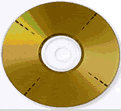 The CD-Check Test Disc is a very useful tool for evaluating the Sound Reproduction
/ Error correction capabilities of a CD player. The disc offers a signal combination
with disc error patterns to rate the drive's abilities to read music and reproduce
it completely. Five tracks on the disc contain a sequence of progressively
more difficult tests. These tracks are referred to as Check Level-1 through
Check Level-5.
The CD-Check Test Disc is a very useful tool for evaluating the Sound Reproduction
/ Error correction capabilities of a CD player. The disc offers a signal combination
with disc error patterns to rate the drive's abilities to read music and reproduce
it completely. Five tracks on the disc contain a sequence of progressively
more difficult tests. These tracks are referred to as Check Level-1 through
Check Level-5.
The
tracks are reproduced through a software multimedia player (i.e.
Windows Media Player). Each level is considered as passed, if the tone
is smooth, continuous without interruptions, skipping or looping. The higher
the Check Level passed, the more reliable the sound reproduction
of the tested drive.
|
Error Level |
1 |
2 |
3 |
4 |
5 |
|
Plextor PX-760A |
5/5 |
5/5 |
5/5 |
5/5 |
5/5 |
The drive successfully passed 5 out 5 check levels for this test. Very few but the best drives are capable of reading the 5th level. The Plextor drive managed to read all the entire test disc without problems.
- Summary
Overall, the drive showed very good CD error correction capabilities, especially if we keep in mind the performance with the CD-Check Test Disc.
4. DVD Error Correction
In the following tests, we checked the DVD reading capabilities of the Plextor PX-760A drive with scratched / defective DVD media. For our tests, we used CDVD Benchmark and Nero CDSpeed . The reference test media comes from ALMEDIO.
- Single Layer media
ABEX TDR-821
This is a single sided, single layer DVD-ROM with a 4.7GB capacity, and its surface has an artificial scratch varying in dimensions from 0.4 to 3.0 mm.

The following transfer rate picture comes from the CDVD Benchmark v1.21 transfer rate test.

The PX-760A managed to read without a hitch, all the way to the end of the test, without any drops in speed, although the max reading speed was not achieved, with the drive reaching only 8X reading speed.
ABEX TDR-825
This is also a single sided, single layer DVD-ROM of 4.7GB capacity. The data structure of the disc is exactly the same as that of the TDR-821, the only difference being that there are no scratches on it. Instead, there are defective areas, ranging in dimensions from 0.5 to 1.1 mm.

There are also fingerprints sized between 65 and 75 micrometers.
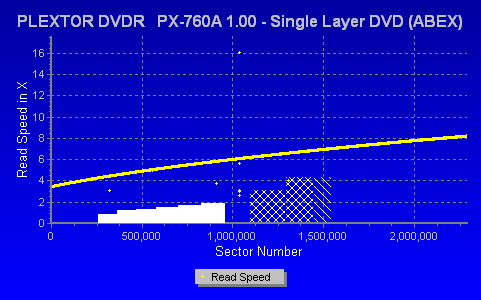
Once again the disc was read flawless, very smooth graph, but 8X maximum reading speed again.
- Dual Layer media
ABEX TDR-841
This is an 8.5GB dual layer single sided DVD-ROM disc with artificial scratches ranging in dimensions from 0.4 to 3.0mm, on both layers.

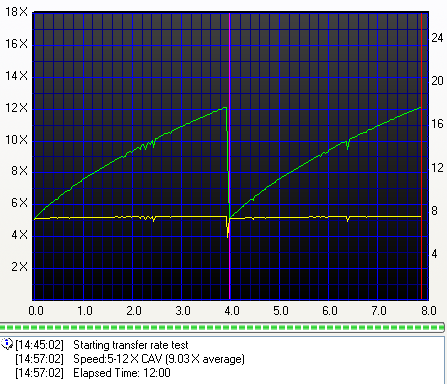
Both Layers were read successfully, with 12X maximum reading speed.
ABEX TDR-845
The disc is a single sided, dual layer DVD-ROM disc of a 8.5GBcapacity. The only difference between the TDR-845 and the TDR-841 is that the former includes defective areas and fingerprints.

The dimensions of the defective areas range from 0.5 to 1.1 mm and the fingerprints are sized from 65 to 75 micro-meters.

Very good performance, no errors were reported and 12X reading speed was reached again.
ABEX TDV-541
The TDV-541 is a single sided, dual layer DVD-VIDEO disc, with a capacity
of 8.5GB. The disc is based on the TDV-540 series which was designed to inspect and adjust DVD-VIDEO players. The disc checks the layer switch operation
from layer 0 to layer 1 and also includes test pictures and test signals on
DVD sound files.

The current TDV-541 also checks the error correcting capabilities of
the drive. It also includes scratches from 0.4 to 3.0 mm.

The drive managed to complete its reading of this test media, but with a severe cost in speed. Drops in reading speed occurred in both layers, and in general, the drive did not do a good job with this disc.
ABEX TDV-545
The TDV-545 disc is based on the TDV-540 series. It is a single sided, dual layer DVD-VIDEO disc with a capacity of 8.5GB. The TDV-545 includes artificial black dots on the data surface, sized from 0.4 to 1.0 mm. It has also 65 - 75 micro meter fingerprints.


Back on track again with nice steady reading. The drive managed to read flawlessly the 545 test disc.
- Summary
Overall, very good DVD error correction capabilities were reported from the Plextor PX-760A drive, with the exception of the TDV 541 test disc. The TDR 821 and TDR 825 discs were read at speeds slower than maximum, while the rest were read at the maximum available.
5. Protected Discs
At this point, we will check the drive's ability to read and backup protected CDs.
- AudioCD protections
 For the test procedure we used three audio discs with different audio copy protections. The ripping process on all protected Audio discs was carried out with Exact Audio Copy v0.9 beta5.
For the test procedure we used three audio discs with different audio copy protections. The ripping process on all protected Audio discs was carried out with Exact Audio Copy v0.9 beta5.
The protected Audio discs tested, were:
| Audio Discs |
Protection |
| Celine Dion - New Day Has Come |
Sony's Key2Audio |
| Natalie Imbruglia - White Lilies Island |
Cactus Data Shield 200 |
| Aiko Katsukino - The Love Letter |
Cactus Data Shield 200.0.4 - 3.0 build 16a |
The Cactus Data Shield 200, contains artificial errors that are not easily bypassed by the reader, while the Key2Audio contains a second session causing problems to readers when trying to read the Table Of Contents (TOC).
The tested tasks are:
- Recognition of the inserted disc (Yes/No).
- Ripping all wav files (with EAC's Burst Mode) to the hard disk through copy&compare function.
- Listening to the produced wav files to detect any possible clicks/skips.
The drive recognized up to the 12th Audio track on the CDS200 disc,

and with the "Retrieve Native TOC" option removed, the drive recognized the 13th track.

The test results are shown in the following table:
| Plextor PX-760A |
Key2Audio |
CDS200 |
| Ripping process completed, EAC reports no problems, Read&Test CRC comparison successful for all tracks |
Ripping process completed, EAC reports no problems, Read&Test CRC comparison successful for all tracks |
Both protected Audio discs were ripped and reproduced successfully.
- Cactus Data Shield 200.0.4 - 3.0 build 16a (Aiko Katsukino - The Love Letter)
This is a "special" CDS200 build, since it doesn't contain any artificial errors which create problems during the ripping process. Most problems occur when trying to write the ripped wav files, since the produced CD-R disc contains C2 and CU errors! This "problem" is rumored to be connected to specific chipset weaknesses.
| Plextor PX-760A |
CDS 200.0.4 - 3.0 build 16a |
| Reading performed without any errors. |
- Games Protections
 To create the image of the various protected titles in the hard disk, we used Alcohol 120% software and the appropriate settings, in accordance with the protection type of the inserted discs. Below you can see the duration of each process as well as the transfer rate in each case.
To create the image of the various protected titles in the hard disk, we used Alcohol 120% software and the appropriate settings, in accordance with the protection type of the inserted discs. Below you can see the duration of each process as well as the transfer rate in each case.




With the PSX and SecuROM protected media, the Plextor reported average to good ripping times, but when it comes to SafeDisc protection, it leaves the rest way behind. One of the very few drives that can perform satisfactorily with all game protection schemes.
- Writing Tests
The Plextor PX-760A supports the DAO-RAW writing mode. To check the drive's EFM correction status we used 5 different game titles with different SafeDisc 2 versions, having the latest software patches installed. After making the images of the various titles onto the hard disk, we burned them (at maximum speed) with Alcohol 120% v1.9.2.3105. Two different discs were recorded for each title; one with the "Rectify Sub-Channel Data" enabled and one with the function disabled.
- Quake 4 SafeDisc v4.6
- Fifa 2004 - SafeDisc v3.1x
The drive failed to create working backups of the above protected games.
6. CD Recording Tests
The drive supports 8X, 16X, 24X, 32X, 40X and 48X writing speeds.

According to Nero CDSpeed, the reported average speed when recording at 48X
is 36.68X.

- CD-R Recording Times
We created an 80min data compilation with Nero Burning Rom and recorded
it on a 700MB disc. The writing performance varies according to the
media. Below is a chart showing all recording times with
various media.


All tested media were burned at the maximum speed of 48X. The recording times are rather low in comparison with the other drives, though LiteOn seems to be a liitle bit faster.
- Other features
The drive supports CD Overburning up to 99mins.

- CD-RW Format
The Plextor 760A supports 24X (Z-CLV) rewriting speeds, with Ultra Speed Rewritable Media (US-RW).

Below you can see the Nero CD-DVD Speed writing simulation test with blank 24X US-RW media.

The drive, when recording at 24X, reported an average 23.47X writing speed. You will notice in the above graph, that due to a bug with the CD-Speed and Plextor CD/RW strategy, the speed reported at the end of the test (9X CLV) refers only to the starting speed and not the end speed as it should.
7. CD Writing Quality - Plextools
Untitled Document
 We measured the C1 / C2 error rate on the recorded discs we burned at the
various supported writing speeds. The software we used is the latest PleXTools Professional and in particular the built-in Q-Check utility. The Plextor PX-716A was used as the reader.
We measured the C1 / C2 error rate on the recorded discs we burned at the
various supported writing speeds. The software we used is the latest PleXTools Professional and in particular the built-in Q-Check utility. The Plextor PX-716A was used as the reader.
Verbatim 80min 52X @ 48X

CMC 80min 52X @ 48X

MMore 80min 52X @ 48X

Maxell 80min 48X @ 48X

BenQ 80min 52X @ 48X

- Summary
According to the above scans, produced with Plextools Q-check, the reported C1 levels were low but a few C2 values were reported as in the case of BenQ, Maxell and CMC media. In this test, Verbatim and MMore media offered the best quality.
8. CD Writing Quality - Clover System
Untitled Document
The Clover System CDX Compact Disc Analyzer is a high-speed tool to quantitatively measure the quality of a CD. It will analyze CD-DA, CD-ROM, CD-ROM XA, CD-I, CD-R, Photo-CD, Enhanced CD and CD-RW discs at 4X, 8X, 24X, 32X or 40X speeds. It effectively measures disc quality by examining the quantity and severity of CIRC errors generated during playback. It also provides the capability to measure signal parameters related to pit geometry, such as asymmetry and reflectivity. When put together, all these facts provide a thorough analysis of disc quality. The Clover System Analyzers can also perform various format-checking tests on data discs, and do bit-for-bit data comparison on all types of CDs. All tests are carried out at a maximum speed of 40X.
CIRC error correction uses two principles to detect and correct errors. The first is redundancy (extra information is added, which gives an extra chance to read the disc), and the second is interleaving (data is distributed over a relatively large physical area). The CIRC error correction used in CD players uses two stages of error correction, the well known C1 and C2, with de-interleaving of the data between the stages.
The error type E11 means one bad symbol was corrected in the C1 stage. E21means two bad symbols were corrected in the C1 stage. E31 means that there were three or more bad symbols at the C1 stage. This block is uncorrectable at the C1 stage, and is passed to the C2 stage. Respectively, E12 means one bad symbol was corrected in the C2 stage and E22 means two bad symbols were corrected in the C2 stage. E32 means that there were three or more bad symbols in one block at the C2 stage, and therefore this error is not correctable.
BLER (Block Error Rate) is defined as the number of data blocks per second that contain detectable errors, at the input of the C1 decoder. Since this is the most general measurement of the quality of a disc, you will find BLER graphs for all media tested below. If you click on the images you can see a more detailed table, indicating error levels. The Red Book specification (IEC 908) calls for a maximum BLER of 220 per second averaged over ten seconds. Discs with higher BLER are likely to produce uncorrectable errors. Al low BLER shows that the system as a whole is performing well, and the pit geometry is good. However, BLER only tells us how many errors were generated per second, and it does not tell us anything about the severity of those errors.
Verbatim 80min 52X @ 48X

CMC 80min 52X @ 48X

MMore 80min 52X @ 48X

Maxell 80min 48X @ 48X

BenQ 80min 52X @ 48X

- Summary

The burning quality of the drive which we saw in the previous page with Plextools, is not confirmed here. All the tested media, according to Clover Systems, failed, while only BenQ CD-R media got an A grading. The quality could have been better, since we had seen better results from the previous PX-755A model. A new firmware may fix this.
9. DVD Writing Tests
- Writing Performance
Now we will check the burning performance with DVD media. Below, the available writing speeds, as reported by Nero Burning Rom.

By using Nero CDSpeed with DVD+R media, we are able to see for the first time, the 18X writing strategy. For this test we used a Plextor DVD+R media with ID: YUDEN000 T03(000). Click here if you want to check the Plextor Web-site for other 18X compatible media. We also tested the writing strategies at 16X.
- DVD+R media @ 18X P-CAV

- DVD+R media @ 16X P-CAV

- DVD-R media @ 16X CAV

- Burning Tests
DVD-R media

As you can see from the above table, all the DVD-R media were burned at their certified speeds. However, the reported times are high in most cases. In fact, the drive didn't manage to burn any disc in under 7 minutes, even when burning at 16X.

As with DVD-R media, the drive in most cases when burning at 16X, required more than 7 minutes. Only in the case of media with a PRODISC ID, such as Prodisc and Datawrite, was the time was typical of 16X burning. Verbatim and Plextor DVD+R media are 18X compatible and we had expected lower burning times, but as you can see, the recording times are no better than 16X burning times. The drive also oversped Taiyo Yuden 8X media to 12X, but as we
will see later on, it did not produce a good burn at that speed. Nevertheless, we also burned at 16X the 18X compatible media in order to check the burning quality.
- Comparison with other drives


The Plextor PX-760A, possibly due to its 18X burning speed, seems to be faster than the other drives with DVD+R media.
- DVD Overburning Tests

The Plextor PX-760A does not support DVD-/+R overburning.
10. DVD Writing Quality - Page 1
In order to test the writing quality and readability of the burned media, we
used two readers equipped with two software applications:
- The LiteON SOHD-167T with patched firmware being able to read DVD5 up to
16X CAV and DVD9 up to 10X CAV. For the transfer rate tests, we used
the
latest Nero CDSpeed version.
- The Plextor PX-716A with the latest available firmware. For scanning the
disc, we used the latest PlexTools version at 2X CLV reading speed,
BURST mode, with middle accuracy.
In general, a "perfect" disc should have a smooth reading curve,
very low PIE/POE and zero (0) POF error rates. Most times however, even though
a disc has very low PIE/POE error rates, the reading curve may not be smooth
containing
dropoffs.
Due to the fact that we oversped the reading capabilities of the LiteON SOHD-167T,
such drops are expected, especially near the outer area of the disc.
The measurements below should not be taken as the absolute criterion of the
burning quality, but as an indication level.
18X DVD+R Writing Speed
- Plextor 16X DVD+R @ 18X


- Verbatim 16X DVD+R @ 18X


- Summary
Both media produced a smooth reading speed graph with the LiteON in CDSpeed, but with Plextools, the Plextor media reported high error values. At 18X burning speed, Verbatim media seems to offer excellent quality while the Plextor is simply good.
11. DVD Writing Quality - Page 2
In order to test the writing quality and readability of the burned media, we used two readers equipped with two software applications:
- The LiteON SOHD-167T with patched firmware being able to read DVD5 up to
16X CAV and DVD9 up to 10X CAV. For the transfer rate tests we used the latest
Nero CDSpeed version.
- The Plextor PX-716A with the latest available firmware. For scanning the
disc, we used the latest PlexTools version at 2X CLV reading speed, BURST
mode, with middle accuracy.
In general, a "perfect" disc should have a smooth reading curve,
very low PIE/POE and zero (0) POF error rates. Most times however, even though
a disc has very low PIE/POE error rates, the reading curve may not be smooth
containing dropoffs. Due to the fact that we oversped the reading capabilities
of the LiteON SOHD-167T, such drops are expected, especially near the outer
area of the disc.
The measurements below should not be taken as the absolute criterion for the
burning quality, but as an indication level.
16X DVD+R Writing Speed
- Datawrite Classic 16X DVD+R @ 16X


- ProdiscR05 16X DVD+R @ 16X


- ProdiscR04 16X DVD+R @ 16X


- Plextor 16X DVD+R @ 16X


- Verbatim 16X DVD+R @ 16X


- BenQ 16X DVD+R @ 16X


- Philips 16X DVD+R @ 16X


- Optodisc 16X DVD+R @ 16X


- Traxdata 16X DVD+R @ 16X


- RiDisc 16X DVD+R @ 16X


- Datawrite Titanium 16X DVD+R @ 16X


- Maxell 16X DVD+R @ 16X


- Summary
According to CDSpeed and Plextools, the writing quality was good with most of the tested media. Almost all media produced low error values but in some cases, CDSpeed on the LiteOn showed a different picture. If we compare the results with the PX-755A, we could say that the burning quality has undergone some improvements, at least with 16X media. At this point, it is really interesting that the Plextor (TY) media reported low error rates but when it was recorded at 18X, it had high error rates, while Verbatim also reported low error rates but an unsteady speed graph, something which did not happen when the same ID media was burned at 18X. Nevertheless, Maxell media reported low error levels but it could not be read with the LiteOn, so we used another LiteON drive. The results remained the same.
12. DVD Writing Quality - Page 3
In order to test the writing quality and readability of the burned media, we
used two readers equipped with two software applications:
- The LiteON SOHD-167T with patched firmware being able to read DVD5 up to
16X CAV and DVD9 up to 10X CAV. For the transfer rate tests we used the latest
Nero CDSpeed version.
- The Plextor PX-716A with the latest available firmware. For scanning the
disc, we used the latest PlexTools version at 2X CLV reading speed, BURST
mode, with middle accuracy.
In general, a "perfect" disc should have a smooth reading curve,
very low PIE/POE and zero (0) POF error rates. Most times however, even though
a disc has very low PIE/POE error rates, the reading curve may not be smooth
containing dropoffs. Due to the fact that we oversped the reading capabilities
of the LiteON SOHD-167T, such drops are expected, especially near the outer
area of the disc.
The measurements below should not be taken as the absolute criterion of the
burning quality, but as an indication level.
12X DVD+R Writing Speed
- Ricoh 16X DVD+R @ 12X


- Taiyo Yuden 8X DVD+R @ 12X


- Summary
Ricoh media is 16X certified but the Plextor PX-760A burnt it at 12X. The reading graph is smooth although the error levels are a little bit high. Taiyo Yuden media is 8X certified but the drive oversped the burn, producing high error levels and an unsteady speed graph.
13. DVD Writing Quality - Page 4
In order to test the writing quality and readability of the burned media, we
used two readers equipped with two software applications:
- The LiteON SOHD-167T with patched firmware being able to read DVD5 up to
16X CAV and DVD9 up to 10X CAV. For the transfer rate tests we used the latest
Nero CDSpeed version.
- The Plextor PX-716A with the latest available firmware. For scanning the
disc, we used the latest PlexTools version at 2X CLV reading speed, BURST
mode, with middle accuracy.
In general, a "perfect" disc should have a smooth reading curve,
very low PIE/POE and zero (0) POF error rates. Most times however, even though
a disc has very low PIE/POE error rates, the reading curve may not be smooth
containing dropoffs. Due to the fact that we oversped the reading capabilities
of the LiteON SOHD-167T, such drops are expected, especially near the outer
area of the disc.
The measurements below should not be taken as the absolute criterion of the
burning quality, but as an indication level.
8X DVD+R Writing Speed
- Datawrite Titanium 8X DVD+R @ 8X


- Bulkpaq 8X DVD+R @ 8X


- Datasafe 8X DVD+R @ 8X


- CMC 8X DVD+R @ 8X


- BenQ 8X DVD+R @ 8X


-Datawrite 8X DVD+R @ 8X


- Optodisc 8X DVD+R @ 8X


- RiDisc 8X DVD+R @ 8X


- Maxell 8X DVD+R @ 8X


- Summary
As we can see from the above quality scans from Plextools Pro and CDSpeed, the reported quality is generally good with 8X certified media. In most cases, the reported quality was more than satisfactory, while only RiDisc, Datawrite and Datasafe media reported bad quality results.
14. DVD Writing Quality - Page 5
In order to test the writing quality and readability of the burned media, we used two readers equipped with two software applications:
- The LiteON SOHD-167T with patched firmware being able to read DVD5 up to
16X CAV and DVD9 up to 10X CAV. For the transfer rate tests we used the latest
Nero CDSpeed version.
- The Plextor PX-716A with the latest available firmware. For scanning the
disc, we used the latest PlexTools version at 2X CLV reading speed, BURST
mode, with middle accuracy.
In general, a "perfect" disc should have a smooth reading curve,
very low PIE/POE and zero (0) POF error rates. Most times however, even though
a disc has very low PIE/POE error rates, the reading curve may not be smooth
containing dropoffs. Due to the fact that we oversped the reading capabilities
of the LiteON SOHD-167T, such drops are expected, especially near the outer
area of the disc.
The measurements below should not be taken as the absolute criterion for the
burning quality, but as an indication level.
16X DVD-R Writing Speed
- BenQ 16X DVD-R @ 16X


- Optodisc 16X DVD-R @ 16X

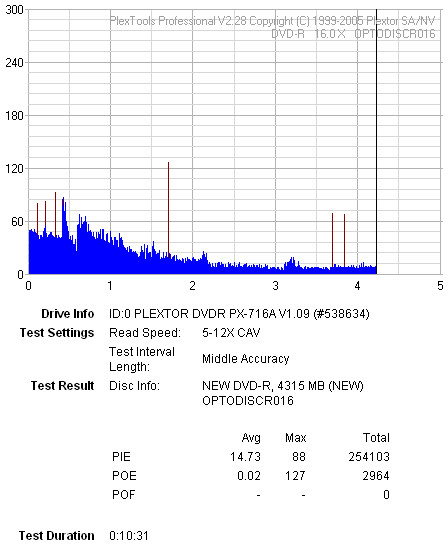
- ProdiscS05 16X DVD-R @ 16X


- ProdiscF02 16X DVD-R @ 16X


- Philips 16X DVD-R @ 16X


- Traxdata 16X DVD-R @ 16X

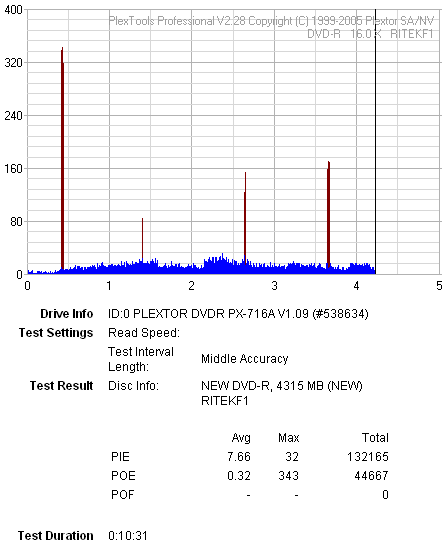
- Datawrite Classic 16X DVD-R @ 16X


- RiDisc 16X DVD-R @ 16X


- MKM 16X DVD-R @ 16X


- Datasafe 16X DVD-R @ 16X


- Datawrite Titanium 16X DVD-R @ 16X


- Maxell 16X DVD-R @ 16X
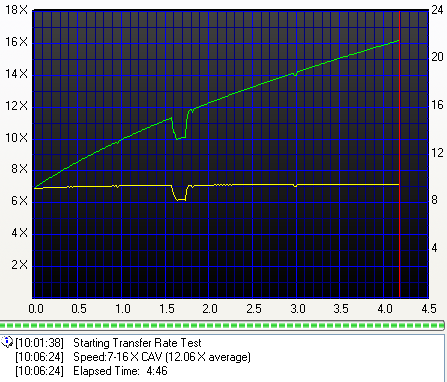

- Ricoh 16X DVD-R @ 16X

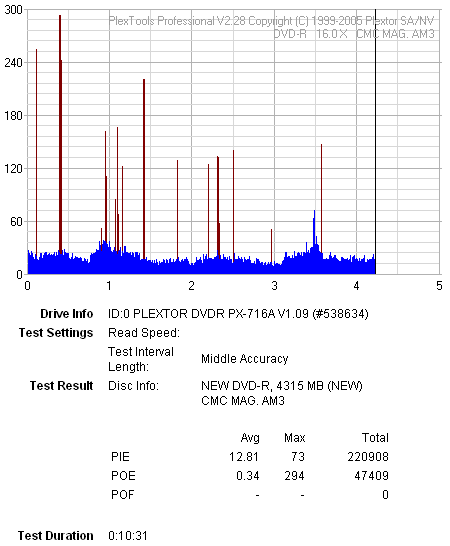
- Summary
The scene is not very different from that of DVD+R at 16X. The CD-Speed graphs are in some cases a little untidy, but almost all media reported error values within limits. Overall, good quality burns.
15. DVD Writing Quality - Page 6
In order to test the writing quality and readability of the burned media, we
used two readers equipped with two software applications:
- The LiteON SOHD-167T with patched firmware being able to read DVD5 up to
16X CAV and DVD9 up to 10X CAV. For the transfer rate tests we used the latest
Nero CDSpeed version.
- The Plextor PX-716A with the latest available firmware. For scanning the
disc, we used the latest PlexTools version at 2X CLV reading speed, BURST
mode, with middle accuracy.
In general, a "perfect" disc should have a smooth reading curve,
very low PIE/POE and zero (0) POF error rates. Most times however, even though
a disc has very low PIE/POE error rates, the reading curve may not be smooth
containing dropoffs. Due to the fact that we oversped the reading capabilities
of the LiteON SOHD-167T, such drops are expected, especially near the outer
area of the disc.
The measurements below should not be taken as the absolute criterion of the
burning quality, but as an indication level.
8X DVD-R Writing Speed
- Opto 8X DVD-R @ 8X


- ProdiscF01 8X DVD-R @ 8X


- BenQ 8X DVD-R @ 8X


- CMC 8X DVD-R @ 8X


- Datawrite Yellow 8X DVD-R @ 8X
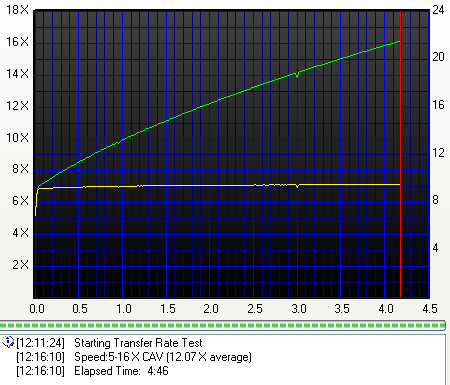

- Datasafe 8X DVD-R @ 8X


- Traxdata 8X DVD-R @ 8X


- RiDisc 8X DVD-R @ 8X


- Maxell 8X DVD-R @ 8X


- Datawrite Titanium 8X DVD-R @ 8X


- Datawrite 8X DVD-R @ 8X


- Bulkpaq 8X DVD-R @ 8X


- Summary
At 8X writing speed, it is obvious that the reported media quality is good, with the exception of Datawrite Yellow, Optodisc and Bulkpaq where the PO values were rather high.
16. DVD Writing Quality - Page 7
In order to test the writing quality and readability of the burned media, we
used two readers equipped with two software applications:
- The LiteON SOHD-167T with patched firmware being able to read DVD5 up to
16X CAV and DVD9 up to 10X CAV. For the transfer rate tests we used the latest
Nero CDSpeed version.
- The Plextor PX-712A with the latest available firmware. For scanning the
disc, we used the latest PlexTools version at 2X CLV reading speed, BURST
mode, with middle accuracy.
In general, a "perfect" disc should have a smooth reading curve,
very low PIE/POE and zero (0) POF error rates. Most times however, even though
a disc has very low PIE/POE error rates, the reading curve may not be smooth
containing dropoffs. Due to the fact that we oversped the reading capabilities
of the LiteON SOHD-167T, such drops are expected, especially near the outer
area of the disc.
The measurements below should not be taken as the absolute criterion of the
burning quality, but as an indication level.
DVD+RW and DVD-RW Media
- MKM 8X DVD+RW @ 8X


- Traxdata 6X DVD-RW @ 6X

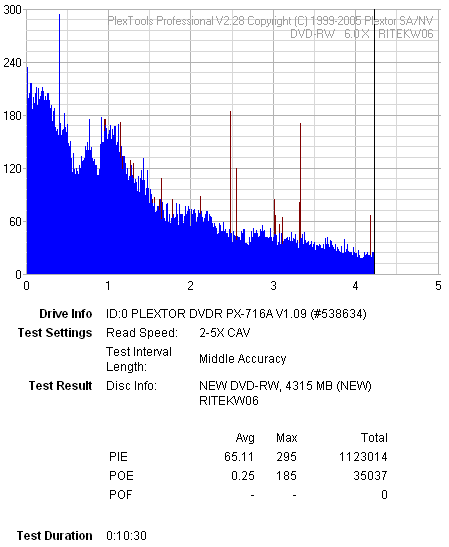
- MKM 6X DVD-RW @ 6X


- Summary
Relatively good performance was reported with DVD+/-RW media, with low error rates from Plextools and in the main, smooth graphs with the LiteOn. In comparison with the PX-755A, we can say that a lot of improvement have been made here.
17. DVD Writing Quality - Almedio
The AEC-1000 consists of a DVD Drive and the "ALChecker" error measurement application which can check the written data quality. The application is capable of 1X CLV measurement as well as 4X CLV with DVD-Video/ROM and finalized DVD+R/-R media.
There are three measurement modes:
- Fine Mode: checks a series of eight consecutive ECC blocks,
- Rough Mode: checks eight consecutive ECC blocks every 100h ECC blocks
- Quick Mode: checks three specified areas
The checking status is shown graphically in real time while you can save the error graph at the end of the test. The reported errors are the PI and the UncPO. The PI counts the number of rows corrected by the PI error correction in each group of eight consecutive ECC blocks. The UncPO counts the number of ECC blocks in which more than one bytes are uncorrectable in eight consecutive ECC blocks. For our quality scans, we set for 1X CLV and Fine Mode which is the slowest and produces the safest results.
- Datasafe 8X DVD+R @ 8X

- Datawrite 8X DVD+R @ 8X

- RiDisc 8X DVD+R @ 8X

- Taiyo Yuden 8X DVD+R @ 12X

- Datawrite Classic 16X DVD+R @ 16X

- Traxdata 16X DVD+R @ 16X

- Maxell 16X DVD+R @ 16X

- Plextor 16X DVD+R @ 18X


- Verbatim 16X DVD+R @ 18X


- Summary
According to Almedio AEC-1000 error checker, the drive has average writing quality. The media we chose to measure are those which either failed in CDSpeed or produced unsteady graphs with the LiteOn reader or had high error rates with Plextools. We also measured all the 18X burned media. The errors that we had seen with Plextools are confirmed here in the case of Traxdata, Plextor 18X, Taiyo Yuden and Datasafe, while another disc that had high error values with Plextools, reported good quality with the Almedio checker. In any case, at 18X, the quality seems to remain an issue, where only Verbatim reported good quality and Plextor (Taiyo Yuden) failed to maintain low error values.
18. DVDR DL - Page 1
- Writing Tests
We burned some DVD+R DL and DVD-R DL discs with data content. For this task we used "Create Data Disc" from Nero CDSpeed in order to burn the entire disc.
Mitsubishi Chemicals 8X DVD+R DL @ 10X Z-CLV

The specific DL disc from Mitsubishi Chemicals is certified for 8X burning. Since it is quite new, most burners do not support it at 8X, while Plextor supports it not only at 8X burning, but also at 10X... :-)
According to the graph, the writing strategy is Z-CLV. The reported time of 15:21min is rather slow, something that can be explained with the graph. The drive starts the burning process at 6X and then increases gradually up to 10X before dropping back down to 8X for almost 100MB. Then it speeds up to 10X for while before stepping down to 8X and 6X just before the layer change. It remains at that speed until the 4.6 GB mark, at which point it steps up to 8X and remains there until just before the end, where it decreases down to 6X.
Mitsubishi Chemicals 4X DVD-R DL @ 6X CLV

Using CLV strategy, the drive managed to write at 6X burning speed, which is the maximum speed for the drive with -R DL media.
RICOH 8X DVD+R DL @ 8X P-CAV

While using P-CAV writing strategy, the drive managed to complete the writing test in 16.39:mins, reporting an average speed of 7.13X. The media was burned at its certified speed, but the 8X speed was not used over the entire DVD.
19. DVDR DL - Page 2
- Writing Quality
In order to test the writing quality and readability of the burned media, we used two readers equipped with two software applications:
- The LiteON SOHD-167T with patched firmware being able to read DVD5 up to 16X CAV and DVD9 up to 10X CAV. For the transfer rate tests we used the latest Nero CDSpeed version.
- The Plextor PX-716A with the latest available firmware. For scanning the disc, we used the latest PlexTools version at 2X CLV reading speed, BURST mode, with middle accuracy.
In general, a "perfect" disc should have a smooth reading curve, very low PIE/POE and zero (0) POF error rates. Most times however, even though a disc has very low PIE/POE error rates, the reading curve may not be smooth containing dropoffs. Due to the fact that we oversped the reading capabilities of the LiteON SOHD-167T, such drops are expected, especially near the outer area of the disc.
The measurements below should not be taken as the absolute criterion of the burning quality, but as an indication level.
- MKM DVD+R DL 8X @ 10X


- MKM DVD-R DL 4X @ 6X


- Ricoh DVD+R DL 8X @ 8X


- Summary
According to the CD-Speed utility, all the tested media reported
good quality, with generally smooth speed graphs, while with Plextools, all media reported error levels that were within the acceptable limits.
Overall, good quality scans, especially with MKM DVD-R DL media.
20. PX-760A vs CATS - Page 1
For checking exactly what
the PX-760A reports, we used three different media, burned with other
recorders. The three media have been measured with the well known AudioDev
SA300 DVD
CATS system at 1X.
The drive is capable of reporting PI/PIF errors, so we will compare those
measurements at the 8X reading speed.
Please note, that the posted results are only valid for the specific tested PX-760A drive. Using other drives, even another PX-760A, can produce totally different
results. Beware!
#1st Test Disc - PISum8/PIF Comparison - 8X Reading speed




From the above graphs, we can see that the error line trend follows the same pattern as the original CATS scans.
21. PX-760A vs CATS - Page 2
For checking exactly what the PX-760A reports, we used three different media, burned with other recorders. The three media have been measured with the well known AudioDev SA300 DVD CATS system at 1X.
The drive is capable of reporting PI/PIF errors, so we will compare those measurements at 8X reading speed.
Please note, that the posted results are only valid for the specific tested PX-760A drive. Using other drives, even another PX-760A, can produce totally different results. Beware!
#2nd Test Disc - PISum8/PIF Comparison - 4X Reading speed




In this case, the graph is different to that of the CATS error line.
22. PX-760A vs CATS - Page 3
For checking exactly what the PX-760A reports, we used three different media, burned with other recorders. The three media have been measured with the well known AudioDev SA300 DVD CATS system at 1X.
The drive is capable of reporting PI/PIF errors, so we will compare those measurements at 8X reading speed.
Please note that the posted results are only valid for the specific tested PX-760A drive. Using other drives, even another PX-760A, can produce totally different results. Beware!
#3rd Test Disc - PISum8/PIF Comparison - 8X Reading speed




The trend line follows the CATS trend line.
23. PX-760A vs CATS - Page 4
For checking exactly what the PX-760A reports, we used three different
media, burned with other recorders. The three media have been measured
using the well known AudioDev SA300 DVD CATS system at 1X.
The drive is capable of reporting PI/PIF errors, so we will compare those measurements at 8X reading speed.
Please note that the posted results are only valid for the specific tested PX-760A drive. Using other drives, even another PX-760A, can produce totally different
results. Beware!
#4th Test Disc - PISum8/PIF Comparison - 8X Reading speed
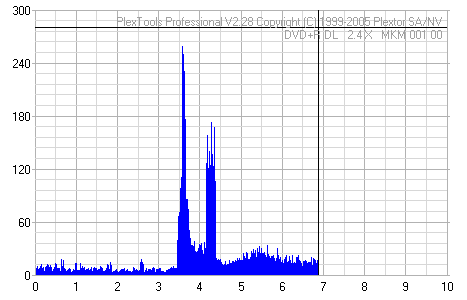

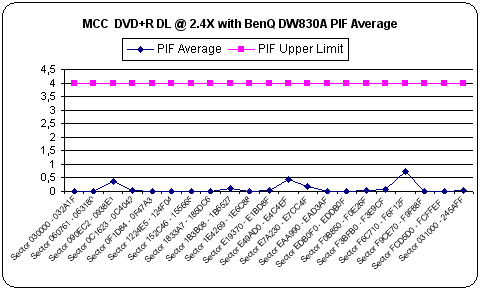

And lastly, a somewhat close trend line to the original CATS, but only for the PIF measurement.
24. Booktype Setting
The booktype setting is a feature widely supported by almost all recent drives, as it enables the change of the booktype on specific media (DVD+R,+RW,+RDL to DVD-ROM), to achieve maximum compatibility with stand alone players (mostly outdated ones). This can be achieved prior to burning the inserted media or during the burn process (at the beginning with Nero or another burning software).
Unfortunately, the Plextor 760A does not fully support this feature for all media. It can only change the booktype for DVD+R DL and DVD+R media to DVD-ROM, DVD+RW is not supported and by default, the book type is DVD-ROM. The booktype cannot be changed with Nero CDSpeed, you will have to use Plextools in order to change the booktype.

25. Media Quality Check Utility
In this page, we are going to test the
Media Quality Check utility, which, according to Plextor, can check the best writing speed for any inserted media.
In order to test this function, we used three of the DVD+R media that were ranked by Almedio AEC-1000 as BAD condition.
Let's see what we get...

- Datasafe 8X DVD+R

- RiDisc 8X DVD+R

- Traxdata 16X DVD+R

It seems that Plextools has a different opinion, setting all the above media as good burns. But as we have seen in the previous tests, with the specific media burned at the speed that Plextools indicated, the quality was far from good.
26. Q-Check TA Function
PX-760A, as with the PX-716A and PX-716A in the past, supports the advanced Q-Check function with
the two acronyms "TA", that are the initials for Time Analyser.
Plextools explains exactly what the test measures:

As we have mentioned in our previous reviews, this advanced Q-Check function checks the geometry of pit
and lands on a recorded disc. As most of you know, the DVD specifications
specify the length of both pits and lands as multiplies of the T time period
of the clock. The Q-Check function checks whether there are any variations
in the size of the pit/land spots on a recorded disc, compared to the theoretical
values (3T-14T). In extreme cases where these variations are significant,
reading could result in read errors.
So, once again we checked this function with two different
discs, one single layer (MCC DVD+) and one dual layer (MCC DVD+R DL). Both
discs were those we also scanned in the PI/PO Test in order to make a comparison with
the SA300 CATS analyzer.
Single Layer Disc
After choosing the test and pressing start, you can select from three zones
to "scan", inner/middle/outer for the appropriate disc zone:

The test results will vary from disc to disc and from zone to zone, however
user can easily test a full disc in less than a minute, since each zone takes approximately 10 seconds to finish:





Dual Layer Disc
If the inserted disc is a dual layer (DL), user can select inner/middle zone at Layer 0/1, as the following picture illustrates:
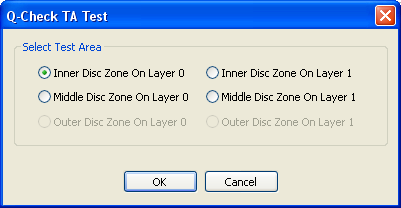







27. Autostrategy
As most of the latest Plextor DVD burners, the PX-760A supports the Autostrategy feature. According to Plextor, this is a technology that determines the standard deviation of any blank disc and automatically optimizes the write strategy for unknown media, enabling high-quality disc recording.
You can learn more about it from Plextools:

Click to enlarge
A separate database collects all strategies that were created by the AUTOSTRATEGY function for media which are not yet supported in the firmware. These strategies are additional to the write strategies of supported media that are stored in the firmware. A maximum of 31 write strategies can be held in the non-volatile memory of the drive. The entries can be activated or de-activated, and deleted.The list of database entries can be viewed and saved or printed.
The user can select if he prefers to use the write strategy from the
AUTOSTRATEGY database, or from the database that resides in the drive's firmware by activating a different Mode.
1. Auto Selection Mode
The drive will select the best write strategy, whether it is located in the AS Database or in the firmware database. If no suitable strategy is found, AUTOSTRATEGY will create a new, optimised strategy in the AS Database.
2. AS On Mode (Forced)
The drive will create a new write strategy for every new recording, whether a corresponding strategy exists already ( in the firmware) or not.
3. AS On Mode
The drive will use the write strategies from the AS database for recording. If no suitable strategy is found, a corresponding write strategy from the firmware's database will be used.
4. AS off Mode
The drive will only use the strategies from the firmware's database for recording. If no corresponding write strategy is found, the default write strategy will be used.

In our first attempt, we turned off the AS feature so the drive will only use the strategies from the firmware's database for recording. In that case, you'll receive the following message.

Then we opened the AS Database...

...and we deleted all entries, and created a new one using this time, the "AS On Mode (Forced)" option.

After the recording, the new writing strategy was added in AS Database.

We used Nero's CD/DVD Speed and its Create Data Disc function in order to burn our discs, while we would also be able to see the writing strategy's details.
- AS off Mode

Click to enlarge
- AS On Mode (Forced)

Click to enlarge
With the AS off, the time needed was 5:59min. The drive delayed during Leadin with AS On Mode (Forced) and the burning process finished after 7:07min. If you check the above graphs, you'll notice that there are some differences in speed drop-offs and also in writing strategy.
Now, what about the differences in writing quality, does this feature actually work?
We used two different methods to measure the writing quality on the discs we burned. First, with Plextools V2.31 and the Plextor PX-760A drive and second with Almedio's AEC-1000 "ALChecker" analyzer.
- Plextools

AS off Mode

AS On Mode (Forced)
Plextools reported increased PIE error levels with AS off Mode, at the end of the disc. With AS On Mode (Forced) the PIE errors reported were 10 times lower.
- Almedio

AS off Mode

AS On Mode (Forced)
With both AS off Mode and AS On Mode (Forced), Almedio's AEC-1000 "ALChecker" analyzer reported Uncorrectable PO errors, but with AS off Mode, those were 3 while with AS On Mode (Forced) only 1. Moreover, there were many more PI errors with AS off Mode, 707 to 66, than with the AS On Mode (Forced).
28. Conclusion

Plextor's PX-760A is the first 18X burner to be launched on the market. However, the DVD-R DL writing speed remains at 6X. All tests have been done with the auto selection mode enabled in order to let the drive choose the best writing strategy.
As a CD reader, the PX-760A is one of the fastest out there, supporting 48X reading speed, while it is also fast as a DVD reader. DVD+/-R/ROM can be read at 16X, while DL media can be read at 12X. As a DVD ripper, the PX-760A is quite fast, but remember to disable the riplock function, by pressing the eject button for three seconds without any disc inserted.

The PX-760A provides very good CD error correction, managing to read all five tracks of the CD Check Audio Test Disc, while it also performed admirably with the ABEX 721R disc and had a perfect score with the ABEX 721 test disc. In our DVD error correction tests, the drive performed even better although in a few cases, reading never reached maximum speed. All tested DVDs were read successfully without any errors, with the only glitch occurring with the ABEX TDV-541 test disc. Ripping protected discs is not a strong point for the PX-760A drive, despite the fact that it read the Safedisc v2 protected disc at high speeds, but this is an old protection and is not being used anymore. Nevertheless, the drive failed to bypass the latest game protections but it did successfully rip all the protected audio CDs that we tried.
CD-R writing quality is rather low, and despite the fact that in Plextools, the error levels were within the acceptable limits, Clover Systems had a different opinion, which judged that none of the discs had excellent quality. For the first time, we tested DVD+/-R at 18X burning speed, which is the highest available speed to date. However, the quality depends on the brand, with Plextor (Taiyo Yuden) 18X media that we tested producing high error levels in Plextools which were confirmed by Almedio AEC-1000. Verbatim on the other hand, even at this high speed, reported high quality. Nevertheless, we recommend lower burning speeds for better results. At 16X, the drive performed well, however the quality again was dependent on the media.
With DL media, the drive supports 10X for DVD+R DL and 6X for DVD-R DL. The quality here was good and the error levels were within the limits, while with RW media, the error levels were low with reasonably smooth speed graphs from CDSpeed.
As for Book-type, the drive cannot change the book-type for DVD+RW media. However, by default, it is set to DVD-ROM. :-) Oh, and if you want to change the book-type for the rest of the media, don't forget to install Plextools because only from there, will you be able to set it.
- The Good
- 18X DVD+/-R burning speed
- 10X +R DL burning speed
- Very good CD/DVD error correction
- Supports protected Audio discs
- Writing Quality with most media
- We liked the Media Quality Check utility
- Plextools is always an advantage for Plextor drives
- Can measure writing quality on CD/DVD media
- The Bad
- Cannot create working backups of SafeDisc's most recent versions
- Does not support DVD overburning
- Cannot read 90/99min audio discs
- Doesn't support Bitsetting change for DVD+RW
- Like to be fixed
- DVD writing quality with specific media
| Retail Package |
 |
| Reading |
 |
| Error Correction |
 |
| Protected Discs |
 |
| Writing |
 |
| Features |
 |